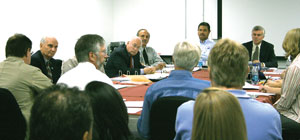CEU’s WETC hosts first Mine Safety meeting
The Utah Mine Safety Commission, which was formed in the aftermath of the Crandall Canyon mine disaster, convened for the first time Sept. 3 at the College of Eastern Utah’s Western Energy Training Center, to gather information about mining industry standards and to discuss possible weak points.
“This first meeting let us all get to know each other, to feel out our individual strengths as board members,” said Price City Mayor Joe Piccolo. “We took a deep look at the history of mine safety in Utah and readied ourselves to assist Utah mines in becoming a safer place.”

This archived article was written by: Kris Kohler
The Utah Mine Safety Commission, which was formed in the aftermath of the Crandall Canyon mine disaster, convened for the first time Sept. 3 at the College of Eastern Utah’s Western Energy Training Center, to gather information about mining industry standards and to discuss possible weak points.
“This first meeting let us all get to know each other, to feel out our individual strengths as board members,” said Price City Mayor Joe Piccolo. “We took a deep look at the history of mine safety in Utah and readied ourselves to assist Utah mines in becoming a safer place.”
Public commentary has shown that some residents fear the commission was organized for the sole purpose of assigning guilt for the recent disaster. However, statements made during the meeting demonstrated that the commission’s goal is to make sure that a disaster like this never happens again in Utah.
“Some things that were made obvious were the differences between Western mines and mines anywhere else in the U.S,” stated Piccolo. “I would like to see more training and career-long certifications made available to all miners, it is my feeling that the more training you have the safer you are.”
The meeting at WETC lasted all day. The room was cramped with media, politicians and mining industry experts. The commissions main agenda was to collect as much information as possible. “It seemed that the underlying goal of the meeting was training,” stated Steve Burge, head of WETC.
According to Burge, training for the mining industry is the same everywhere and the problem is that the conditions in the West are not the same as they are in the Eastern states. There is no standardized geological specific training in place.
“Education and training for the energy industry has always taken a back seat to other programs,” said Dale Evans, head of the College of Eastern Utah’s Mining Department. “Hopefully the Crandall Canyon Mine disaster will sway legislation toward the increase of personnel and funding for more realistic, area specific training programs. We have proposed a plan that if approved will allow us to actually construct a working coal mine laboratory at the WETC training center.
“This will allow miners to train in a real-time environment and get hand on experience in a safe and controlled setting. I feel that with this type of training in place, we will also be able to take mine rescue teams to a whole new level. When it comes to jobs like coal mining, hands-on learning is by far superior to a classroom setting.”
The mining department staff will soon relocate from the CEU campus to the WETC headquarters in Helper,
where, according to Evans, and Burge ,one thing is for certain, If Utah’s newly formed safety commission decides that there needs to be more training to help ensure safety, CEU and WETC are ready to step up to the plate and make it happen.




